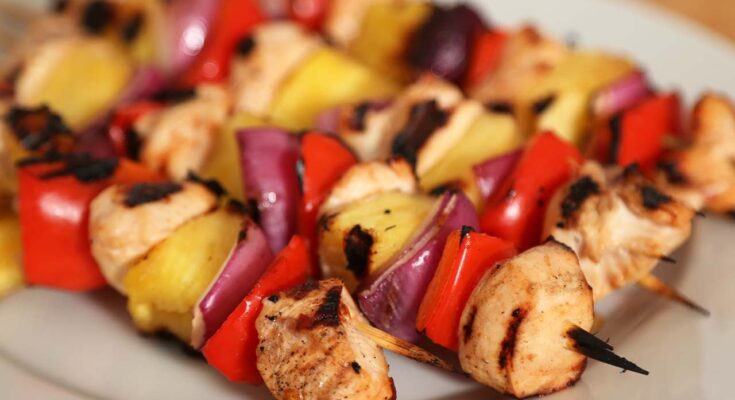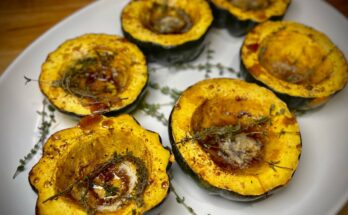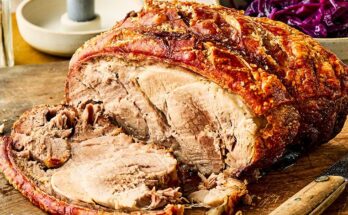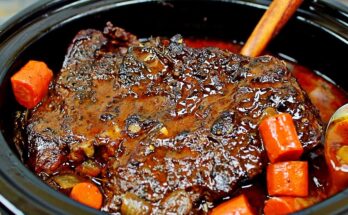Kabob Recipe: Kabobs are one of those magical foods that feel both exotic and comforting at the same time. Whether you’re firing up the grill on a summer day or whipping up a quick dinner, kabobs are versatile, delicious, and visually appealing. But what exactly makes kabobs so special? Let’s dive into this step-by-step guide that will not only show you how to create the perfect kabob but also share tips, tricks, and secrets to make them irresistible!
Why Kabobs are a Perfect Meal
First of all, kabobs offer the perfect balance between protein and vegetables, making them a complete meal on a stick! Plus, they are super customizable—you can tweak them based on what’s in your fridge, your dietary preferences, or even your mood. Kabobs are also fantastic for parties and gatherings because they are easy to serve and even easier to eat. No wonder they’re loved worldwide!
Moreover, kabobs are very family-friendly. Kids love anything on a stick, and adults can appreciate the creative possibilities. You can stick with traditional flavors, or you can get fancy and try international spices for a flavor adventure.
Different Types of Kabobs Around the World
Kabobs (or kebabs) are a global phenomenon. Each region has its spin:
- Middle Eastern Shish Kabob: Marinated lamb or beef chunks grilled with vegetables.
- Turkish Shish Kebab: Often involves tender lamb cubes marinated with yogurt and spices.
- Japanese Yakitori: Small skewers of chicken glazed with a sweet-savory sauce.
- Indian Seekh Kebabs: Minced meat skewers infused with aromatic spices and grilled.
Knowing the different types can inspire you to mix and match flavors from around the world!
Ingredients You Will Need
Protein Choices for Kabobs
The star of any kabob is the protein. You can go classic with beef, lamb, or chicken. Seafood like shrimp and scallops also makes a delicious, lighter option. For a vegetarian twist, try using tofu or paneer.
Here’s a simple list to get started:
- Beef sirloin (tender and flavorful)
- Chicken thighs (juicier than breasts)
- Lamb shoulder (rich and tender)
- Shrimp (quick to cook)
- Firm tofu or paneer (great for vegetarians)
The important part is to choose a protein that stays juicy and doesn’t dry out during cooking.
Vegetables and Marinades
Your kabobs aren’t complete without colorful vegetables. They add flavor, texture, and eye-catching appeal. Think:
- Bell peppers (red, yellow, green)
- Red onions
- Cherry tomatoes
- Mushrooms
- Zucchini
As for marinades, that’s where the magic happens! A good marinade typically includes:
- Oil (like olive oil)
- Acid (like lemon juice or vinegar)
- Spices and herbs
- A touch of sweetness (like honey or brown sugar)
Marinating not only flavors the meat but also tenderizes it, giving you that juicy, melt-in-your-mouth bite.
Essential Spices and Herbs
Spices and herbs are the heart of any good kabob recipe. Depending on the vibe you want (Middle Eastern, Mediterranean, Asian), you’ll adjust your spice blend.
Some must-haves include:
- Cumin
- Paprika
- Garlic powder
- Black pepper
- Thyme
- Oregano
- Chili flakes (for a little kick)
Don’t be shy—spices are your best friends when it comes to kabobs!
Preparing the Ingredients
Cutting Meat and Vegetables
Uniformity is key when prepping for kabobs. Why? Because even-sized pieces cook evenly, avoiding the dreaded overcooked-meat-undercooked-veggie scenario.
- Cut meat into 1.5-inch cubes.
- Slice vegetables into similar-sized chunks.
- Keep soft veggies (like tomatoes) thicker so they don’t disintegrate.
Pro Tip: If using wooden skewers, soak them in water for at least 30 minutes. This prevents them from burning on the grill.
Marinating the Meat for Maximum Flavor
This step is not optional if you want kabobs that burst with flavor! At a minimum, marinate your meat for 1 hour. Overnight is even better.
Simple marinade recipe:
- ¼ cup olive oil
- 3 tablespoons lemon juice
- 3 cloves garlic (minced)
- 1 tablespoon paprika
- 1 teaspoon cumin
- Salt and pepper to taste
Toss your meat in the marinade, cover, and refrigerate. Easy peasy, right?
Assembling the Kabobs
Skewering Tips for Even Cooking
Building kabobs is like creating edible art. The way you skewer your ingredients matters a lot for even cooking and delicious results.
Here’s how to do it right:
- Alternate meat and vegetables to mix flavors beautifully.
- Leave a tiny space between each piece to allow heat circulation.
- Group similar cooking-time items together. For instance, cherry tomatoes cook faster than beef chunks, so either double up the tomatoes or keep them on separate skewers.
Metal skewers are great because they heat up and cook the inside of the meat slightly faster. But if you’re using wooden ones, just remember: soak them beforehand to avoid a fiery disaster!
Pro Tip: Always start and end with a veggie to keep the meat snug in the middle.
Balancing Meat and Vegetables
Getting the perfect balance of meat to veggies is an art. Too many veggies, and your kabobs lack heartiness; too much meat, and you miss out on that refreshing bite.
Aim for a 1:1 ratio: one piece of meat followed by one vegetable. This ensures each bite is flavorful, juicy, and perfectly satisfying.
You can even make themed kabobs like:
- All veggie kabobs for vegetarians.
- Seafood kabobs with lemon wedges skewered between shrimp.
- Meat-lover’s kabobs packed with beef and sausage.
Don’t be afraid to get creative—kabobs are forgiving and super customizable!
Cooking the Kabobs
Grilling Tips and Techniques
Grilling kabobs is where the real magic happens. There’s just something irresistible about the charred bits, the smoky aroma, and the juicy meat.
Here’s a grilling roadmap:
- Preheat your grill: Get it nice and hot before placing the kabobs.
- Oil the grates: This prevents sticking and tearing.
- Place kabobs diagonally: This gives those sexy grill marks!
- Rotate frequently: Turn every 2–3 minutes for even cooking.
- Cook until just done: Overcooking dries out the meat.
General cooking times:
- Chicken: 12-15 minutes
- Beef: 10-12 minutes (medium-rare)
- Shrimp: 6-8 minutes
Use a meat thermometer if you’re unsure—165°F for chicken and 145°F for beef.
And remember: Rest your kabobs for a few minutes before serving to let juices redistribute.
Oven and Stovetop Alternatives
No grill? No problem! You can still achieve mouthwatering kabobs using your oven or stovetop.
Oven method:
- Preheat oven to 425°F (220°C).
- Arrange kabobs on a baking sheet lined with foil.
- Bake for 15-20 minutes, turning halfway through.
- For extra char, broil for the last 2-3 minutes.
Stovetop method:
- Heat a grill pan over medium-high heat.
- Add a little oil to prevent sticking.
- Cook kabobs for 8-10 minutes, rotating often.
Both methods work surprisingly well, giving you juicy, flavorful kabobs without stepping outside!
Serving Suggestions and Pairings
Best Side Dishes for Kabobs
Kabobs are the main event, but a good side dish can take your meal to the next level.
Here are some winning ideas:
- Rice Pilaf: Light, fluffy, and perfect for soaking up juices.
- Greek Salad: Crisp cucumbers, tomatoes, feta, and olives.
- Pita Bread: Ideal for wrapping your kabobs.
- Grilled Corn: Sweet, smoky, and buttery.
Want something lighter? Try a refreshing couscous or quinoa salad. You’ll love the contrast of flavors!
Delicious Sauces to Serve with Kabobs
A great sauce makes kabobs sing. Here are some favorites:
- Tzatziki Sauce: Cool, creamy, and garlicky.
- Chimichurri: Bright and herby with a kick of garlic.
- Peanut Sauce: For an Asian twist.
- Spicy Yogurt Dip: Yogurt mixed with sriracha and lime juice.
Don’t be afraid to mix it up! Offering multiple sauces at your party can wow your guests and let them customize each bite.
FAQs about Kabob Recipe
What kind of meat is best for kabobs?
The best meats for kabobs are tender cuts like sirloin, ribeye, chicken thighs, or lamb leg. They stay juicy and flavorful when grilled.
How do you keep kabobs moist?
Marinate your meat for at least 30 minutes (or up to 24 hours) and avoid overcooking. Also, use veggies with high water content like onions, bell peppers, and zucchini.
Can I use wooden skewers for kabobs?
Yes! Just soak wooden skewers in water for at least 30 minutes before grilling to prevent them from burning.
What vegetables go well on kabobs?
Popular choices include onions, bell peppers, cherry tomatoes, mushrooms, and zucchini. They cook evenly and add great flavor.
How long should you grill kabobs?
Most kabobs grill perfectly in 10–15 minutes over medium-high heat, turning occasionally for even cooking.
Can kabobs be made in the oven?
Absolutely! Bake kabobs at 400°F (200°C) for about 15–20 minutes, turning halfway through.
What is the best way to marinate kabob meat?
Use a mix of oil, acid (like lemon juice or vinegar), herbs, and spices. Let the meat sit covered in the fridge to soak up all the delicious flavors.
Can I prepare kabobs ahead of time?
Yes! You can assemble and marinate them a day in advance. Store them covered in the fridge until you’re ready to cook.
What is the difference between kabobs and skewers?
“Skewers” refer to the stick holding the food, while “kabobs” describe the dish itself — meat and vegetables threaded onto skewers.
Conclusion
Kabobs are more than just food—they’re an experience. From marinating your favorite proteins to skewering colorful veggies, and from sizzling on the grill to diving into each juicy, flavorful bite, making kabobs is pure joy. With this simple step-by-step guide, you’re now ready to create kabobs that’ll impress your family, your friends, and most importantly, yourself.
Remember: Great kabobs are all about balance—of flavors, textures, and cooking techniques. So grab your skewers, fire up your grill (or oven), and let’s get kabob-ing!



